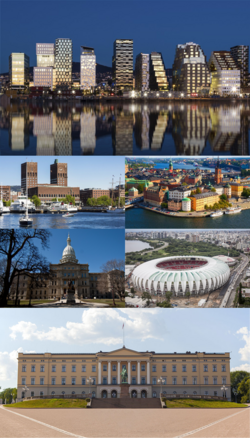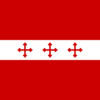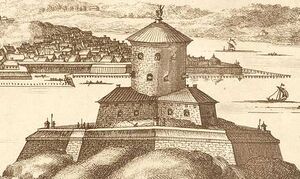Berke
Berke | |
|---|---|
City | |
 Clockwise from top: Berke financial center, Almånbryggen by the Rødelva, Rødkysten Stadion, Det røde presidentpalass, University of Berke's central building, and Berke City Hall. | |
| Nickname(s): Byen av Farger City of Colors | |
| Motto(s): Forente mennesker, sterk by United people, strong city | |
| File:Bfdmap.png | |
| Founded by Sødish natives | 90 CE |
| Government | |
| • Mayor | Jarl Rosten |
| Area | |
| • City | 435 km2 (168 sq mi) |
| • Urban | 3,194 km2 (1,233 sq mi) |
| Population (2016) | |
| • City | 3,144,725 |
| • Density | 7,228.65/km2 (18,722.1/sq mi) |
| Demonym | Berkish |
| Time zone | UTC +0 |
| Area code | (+64) 21 |
Berke (Navish Berke pronounced /'bæɾkɛ/) is the capital and largest city of Navack. The city is located in the eastern shore of the Kalgnat State, in the south of Navack. Berke was renamed after 1921, when the city was still called Kalgnat, the former capital of the United Kingdom of Lhedwin. The Greater Berke conurbation consists of the most populous metropolitan area in the Lhedwinic Channel, with a population of 3.1 million.
The city of Berke is neither part of Kalgnat State nor the State’s capital; rather, it is an autonomous district. In 1921, after the Republican Revolution, the city was federalized, renamed, and removed from the Kalgnat State. The limits of the city stretch beyond both Rød and Blått rivers; it includes both the cities of Blåby to the south, and Gylnebyen to the north, both neighbors cities of Rødhalvøy. The new constitution of 1923 recognized Berke’s autonomy, hence the formal name: Autonomous City of Berke (Autonome Byen Berke). Since 1957 the citizens of Berke are able to vote directly for the City Mayor; previously, the mayor was directly appointed by the President.
Berke is considered to be one of the best cities of Navack, winning several awards that classify the city as one of the best Asuran metropolitan areas to live, work, do business, study, and have fun. Berke, alongside Nasby and Melby, are the only Navish cities to have ever appeared as 1st in the International Rank of Human Development of Cities (IRHDC). Data from the NIGS point Berke as the Navish city with the fastest growth of jobs, specially in the technology field; Berke recieved the XXX award from the NATIONALITYHERE magazine, NAME, in 2015 as the best Lhedwinic city to live.
History
It is known that the peninsula between the Rød and Blått rivers have been inhabited by the Bærk tribe since before the formation of the Sødish conglomerate. Initially, the village was comprised by fishermen trying to escape from the northland harsh weather. By the end of the BCE era, the locality had become an important hub for fishermen and a pitstop for merchants marching to the north.
Due to the constant transit of merchandise, the fishermen village was soon transformed into a toll city between the southern merchant route and all the rest of the Navish and Glanish territory. By 90 CE, Magnus Kalgnat was the responsible for the construction of the first fortress in the region, the Elvevakt Festning, constructing walls all around the routes and the rivers, creating then a gateway to the north. The region soon enriched due to the taxes payed by merchants and travelers. After Maguns’ death, in 102 CE, the local city assembly decided to name the city after its founder, thus becoming the city of Kalgnat. The city quickly became the largest city in the south, being referred by many as the “Capital of the South.” When all the Sødish tribes united in 268 CE, Kalgnat was elected as the new Capital of the Bærk Kingdom, with King Torleif II being crowned as the first King in the South.
When Navack unified in 847 CE, there was a dispute of where the national capital should be: Harhalsen, the Sandish capital; Brestrand, the Ossian capital, or Kalgnat, the Bærkish capital. The new National Jarl Council elected Brestrand, but due to local issues, the decision was moved to Kalgnat. The city remained as the national capital, even after the formation of the United Kingdom of Lhedwin, in 1668. However, after the Great War in 1900, and the Navish Revolution of 1921, Kalgnat was renamed due to the taboo created around the name of the former Lhedwinic capital. The national government voted, in 1923, to rename the city from Kalgnat to Berke, as an homage to the Bærkish tribe, founders of the city.
Transport
Twin towns
Berke is twinned or cooperating with several cities, some of which include :

